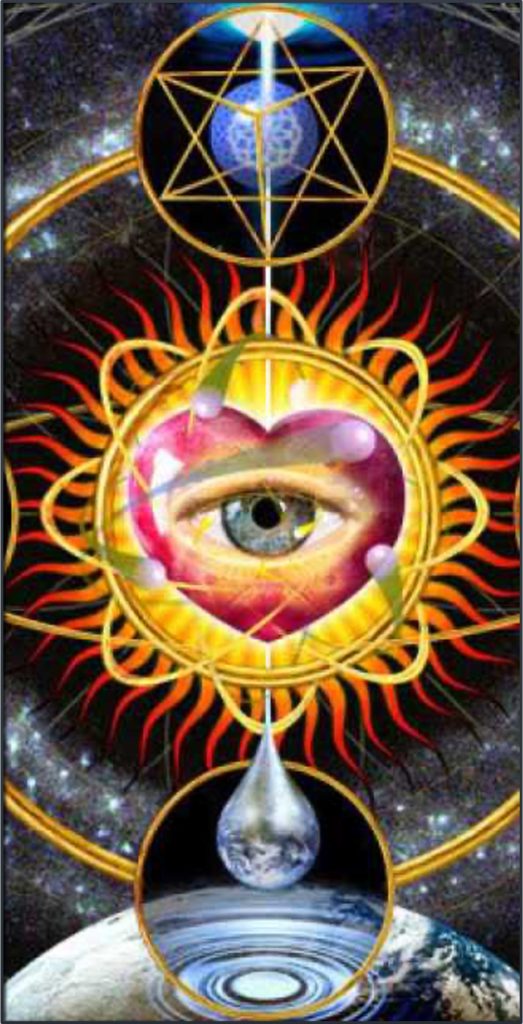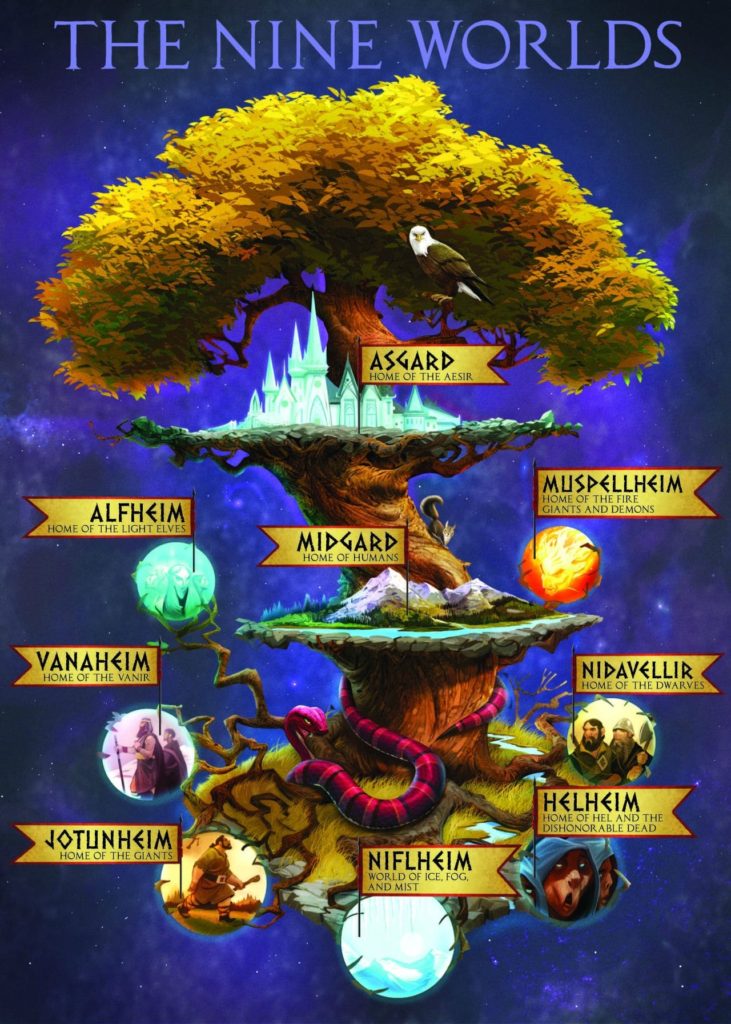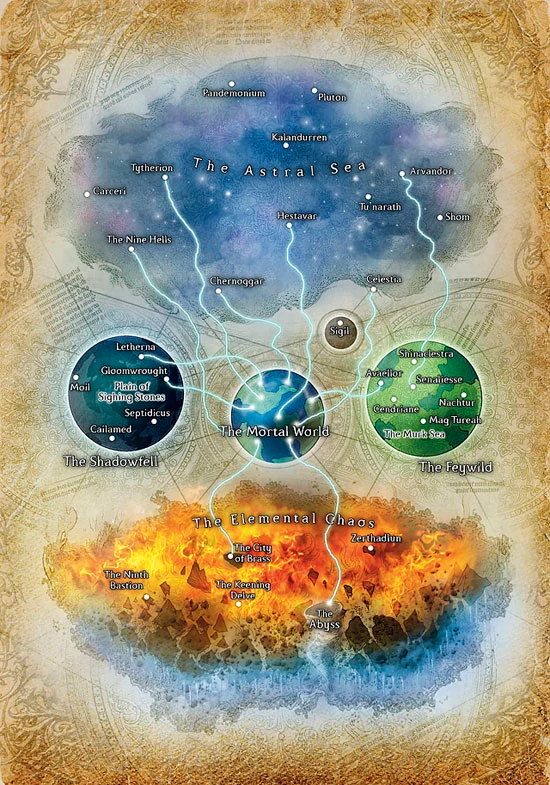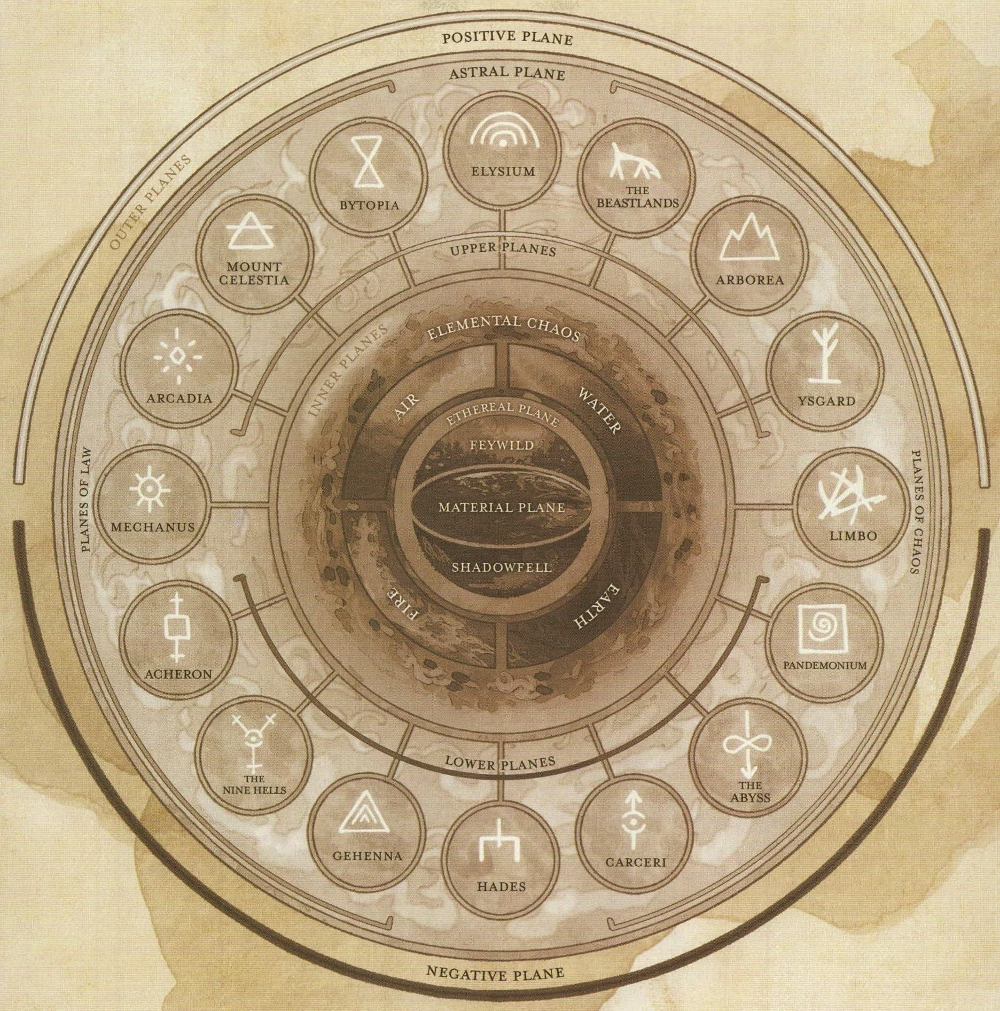
Worlds of might and magic! Territories beyond space and time! Dominions of gods and immortals!
Speculative fiction is rife with stories where the veil between the physical world and beyond is thin, where only those with the knowledge and the power can traverse the complex chaos that exists beyond material existence.
Whether you are a science fiction enthusiast who loves multiverse theories, a sword and sorcery geek who fawns over tales of enchanted realms, an urban fantasy reader who digs stories that take place in the real world but with a twist of magic and mysticism, or a horror fiction buff who entices in the thrills of the supernatural, this topic is for you!
Today, we step through the portal into the realms beyond, and take an analytical look at a beloved trope in fiction; other dimensions, and planes of existence.
A Crash Course on Cosmology
Granted, if you’re like me, you hold a powerful sensation of wonderment in our own universe, especially when looking up to the stars. It’s an amazing place, consisting of celestial bodies floating in the vacuum of space, tugged upon and positioned by gravity, filled with worlds of epic discoveries we have yet to complete as a species. These planets, stars, and galaxies make up a physical cosmology, governed by a robust system of physics, astrophysics, and astronomy.
Fantastical universes may or may not have a physical cosmology themselves. In heroic or epic fantasy tales, these celestial bodies are often not regarded in detail outside of their esoteric meaning to the plot or the world in question. In science fiction however, stars and planets are aplenty, ready to be explored by those with the means to do so.
Yet, even in these universes, there exists that which floats in the furthest unknown. These other worlds, dimensions, planes of existence, and states of being exist beyond that which is material. Dimensional, multiversal, or planar cosmology defines a series of worlds that exist parallel to the material world, but beyond conventional physics.

Some powerful examples are Stranger Things with its notion of the Upside Down, Chronicles of Narnia with its wardrobe of travel between the real world and fantasy, and Dungeons and Dragons with its multi-planar travel and Great Wheel Cosmology.
Even more science fiction entries incorporate this concept with a bit of theoretical (and sometimes more mystical) physics of a more multiversal flavor, whether it is Doctor Who, Star Trek, Warhammer 40k, Everything Everywhere All at Once, and Rick and Morty.
One question that strikes this writer, as it might strike you as well, is where the origins of such ideas come from. We’ll take a brief look into the lineage of such ideas. But first…
A Quick Pseudoscience Disclaimer
Pseudoscience is defined as any alleged body of knowledge, methodology, belief, or practice claiming to be scientific or made to appear scientific, but not adhering to the scientific method.
This material is NOT intended to promote, encourage, enhance, inspire, inform, or justify ANY discussion, belief, presentation, or product which is centered on a religious, spiritual, or pseudoscientific basis.
This material has been gathered and curated SPECIFICALLY for the non-promotional, non-religious, non-scientific, non-spiritual, and purely imaginative nature of building and entertaining our understanding of a topic as it exists in stories, whether they are cultural lore, or in pop culture genre expressions.
Cosmologies of Ancient and Medieval Times
Throughout history, various peoples across the planet have passed on stories of cultural or spiritual significance; stories of Gods, supernatural beings, and places beyond the real world. Tales of the highest heavens, the deepest chasms, and everything in between can be found across various folk tales, religious scriptures, and early philosophical texts.
The earliest notions arrive in shamanistic traditions, as well as from mythological ideas of a vertical world-axis that defines the cosmic order.
- In Greek Mythology, Mount Olympus is the highest heaven and the seat of the gods, whereas the Underworld contains various lairs of dark and monstrous beings.
- Norse Mythology tells of the world tree, Yggdrasill, where all realms of humanity, gods, and mystic beings exist around.
- Mount Meru is the sacred five-peaked mountain that is the center of all physical and spiritual existences in traditional Buddhist, Hindi, and Jain cosmology
- The Great Chain of Being, a concept derived by Plato, Aristotle, and other philosophers, came to define the hierarchical structure of Gods universe in medieval Christianity.
- Islamic cosmology differentiates between the Invisible (“ghyab”) and the Manifest (“shahādat”) as the division of the perceivable, and the unknowable designs of God.
- Two early Greek schools of thought, the Atomists and the Stoics, debated separate theories of the universe.
- Atomists believe the beauty of our world is due to the chaos of colliding atoms, and that these atomic collisions result in an endless number of parallel worlds.
- Stoics believed the cosmos was imbued with an eternal, indestructible soul that recycles itself anew, and will continue to for infinite time.
- Early Buddhist philosophers proposed a cosmology of causation whereas our world was one of many parallel worlds, each of which undergo their own cycles of creation and destruction.
How New Age Spirituality formed the idea of "Planes"

Through the course of time, as religious ideas and cultural boundaries mingled, new schools of metaphysical thought emerged. While this is usually the era where pseudoscientific thought takes full flight, I find its lineage interesting and informative as to where the notion of planes of existence truly begin.
Medieval alchemists proposed ideas about the constitution of the universe through a language of hidden meaning, in which they debated the nature of earths elements and what lie beyond. Writings about the spirits of the world and nature of space gave way to the concept of aether, a “material that fills the region of the universe beyond the terrestrial sphere.”
However, the first uses of the term plane of existence would come in early theosophical texts of the late 1800s. These new age religious texts proposed a cosmology of planes of consciousness and being, based on a synthesis of Western and Eastern ideas.
These would go on to inspire an entire lineage of otherworldly notions that would go to emerge in various modern story genres. While the beliefs of theologians and philosophers have evolved over the eons, no doubt they have emerged into the public consciousness in many stories of folklore, fantasy, science fiction, and other genres.
The Science Fiction Epoch
Naturally, physical cosmology in science fiction par for the course. Countless space faring sagas filled with civilizations adapted to spare-faring travel contain countless star systems, nebulae, and sectors of the galaxy filled with intrigue, strange physics, and phenomena which makes science and magic seem indistinguishable from each other. Likewise, it is here where terms like “celestial” and “planar” give way to terms like “extradimensional“, especially in the reference of beings or anomalies.

Now, I in no way mean to suggest that science fiction is just fantasy in space. Much of modern sci-fi is based upon advanced sciences such as astrophysics, or theoretical physics, choosing to tell a fictional tale with a setting grounded in an enlightened age of science and technology.
Yet, even tales from this genre embrace the unknown in ways that are highly theoretical, or just plain imaginative. One of the biggest tropes of this kind comes from the idea of “hyperspace” (or subspace, jumpspace, nullspace, etc), defined as higher dimension attainable through FTL (faster than light) travel.
Some of my favorite representations of the extra-cosmological in sci-fi comes from the Star Trek universe. You can find almost every scenario of strange science hidden within its multiple series spanning decades of writing. Next Generation and its constant visits from “Q”, Deep Space Nine and the Bajoran wormhole, Voyager with its encounter of Fluidic space. All takes are on display, and nothing is truly certain when you embark into the galaxy.
Quantum Mechanics and Multiverse Theories

Speaking of parallel universes, they’ve gained a particular fascination in the late 2010’s and early 2020’s. Much of that is thanks to sagas such as the Marvel Cinematic Universe, dealing not just with sorcery vs. high technology, but time travel, quantum space, and multiverse travel.
Comic books have had a unique tradition in taking these concepts into the brink of fantasy. Beings such as Doctor Strange, Antman, Loki, Thanos, and Spiderman have come face to face with the limits of reality, and both the power of and chaos of attempting to wield them, such as the notion of the Spiderverse.
In other sagas, you will find parallel universes infinite in number, to be traveled to through time machines, portal guns, or police boxes. Depending on your take, time travel epics such as Back to the Future consider these universes to be separate timelines, manifested by going back and changing the course of history. Doctor Who takes both time and space and molds it into a constant stream of strange encounters and dangerous adventures. Then, you have the highly absurd and satirical universe of Rick and Morty which dials the weird to eleven and pulls no punches with its critique.
Pocket Dimensions
Speaking of dimensions, have you ever wanted to have your own personal dimension? Perhaps a place of retreat, an area of storage, a vault for powerful items, a place of arcane study, or a hideout away from prying eyes?
Then let me interest you in Pocket Dimensions. Think of them like tiny dimensions created by Gods, powerful mages, or high technology. Unlike your typical dimension, this is limited in size, specific in purpose, and unconnected from any other place except by specific means known only to the creator or owner. Going back to the MCU, some might argue that Mirror Dimension functions in much the same way as a pocket dimension, except that it is a full contiguous parallel dimension, which does not count.
However, if you want to see a proper representation of a pocket dimension, the Dungeons and Dragons franchise has plenty of flavors to choose, from Bags of Holding which open to an storage space within a vacuum, to Portable Holes which may allow for a quick escape, to whole realms created by powerful mages for a multitude of purposes.
Folklore Examples of Planar Cosmology

As described earlier in this article, there are a number of cosmologies that have appeared throughout early history.
The Greek and Norse mythologies are terrific examples of those which contain a large multitude of realms, creatures, Gods, and lore.
For a great resource on Norse Mythology, check out Norse Mythology for Smart People.
For those who want to want to delve further into Greek Mythology in particular, Simon E Davies has an amazing infographic and Medium page with useful information about the cosmos according to Olympus.
Pop Culture Examples of Planar Cosmology
If you’re an enthusiast of Dungeons and Dragons, no doubt you’ve seen diagrams and descriptions of the various planes of The Great Wheel Cosmology. Here, the universe is shaped like a giant wheel with each plane connected by “spokes” or portals, which allow beings to travel from one plane to another. At the center is the Prime Material plane, surrounded by the Inner Planes that consist of the fury of the Elemental Planes (Earth, Fire, Water, Air), the enchanted Feywild, the bleak Shadowfell, the ghostly Ethereal Plane, and the consciousness Astral Plane.
The Outer Planes range across the full scope of moral alignments and philosophies, from good to evil, lawful to chaos. Some of the good-aligned planes include Arborea and Elysium and Arborea, with evil-aligned planes such as Gehenna, Hades, and the Abyss, and the neutral-aligned planes such as Limbo and the Beastlands, and several others.


Several other universes employ a cosmology of mysticism and magic. A couple more examples are described below:
- The Elder Scrolls saga, as represented in video games such as Oblivion and Skyrim, tells its stories within the universe known as Aurbis (or the Grey Maybe), which consists of the outer Void, the divine and magical Aetherius, the dark and chaotic Oblivion, and the material realm of Mundis.
- Magic the Gathering, the trading card game, builds its story amongst multiple sets that are released each season. In its lore, we visit various realms such as Ravnica, Mirrodin, Dominara, Amonket, Zendikar, Innistrad, and many more. While each of these realms are considered material in composition, they are extremely diverse in theme and atmosphere.

Building Your Own Cosmology
We’ve embarked on a journey through planes of ancient wisdom, an era of renaissance resurrection, the expanse of a spacefaring saga, and a mind-bending romp through time and space. … Now, lets look into building our own fantasy cosmology!
For the worldbuilders and creatives out there, there are a bunch of methods that can be used to manifest your own strange divine realms and alternate dimensions. If your own story world contains elements of multi-dimensional intrigue, science fantasy, structured divinity, or spiritual esoterica, consider one of these paths of enlightenment in your saga towards manifesting the divine.
Harness the Powers of Existence
Divine planes and alternative dimensions of existence often represent a power which can be represented in the mind by thoughts, objects, memories, and what have you. As such, creating these for a cosmology requires some brainstorming of big universal ideas, and how they might exist in a realm all their own.
What elements exist in your prime material world? What powers structure your universe? Are the worlds that exist beyond your material world defined by forces of nature, rules of physics, ideologies, ethical concepts, abstract ideas, or spiritual esoterica? Are these realms the source of the power in question, or just a representation of its distilled nature?
For example, prevalent in the Forgotten Realms there exist four elemental planes; Fire, Earth, Water, and Air each being a full expression of their truest and most depictive qualities. Beyond that are realms that take from various mythologies, each intended to represent ideas of law, chaos, good and evil. … The Abyss is a chaotic maelstrom of defiling, fiendish entities. Mechanus is a place of massive cogs and automatons of pure order. Bytopia is a land of dual paradises; planes of nature, one upside down from the other, and facing each other 20 miles apart.
Identify your Divine Pantheon
Head forth into the heights of deism and create the gods of your universe. A common theme in speculative fiction and real-life belief systems, realms of the divine are either dominated by, or are preceded by, an entity of immense power. These gods often either embody or govern the concept of which they represent, and their realm reflects their will and nature.
Mount Olympus is the realm of Zeus and his godly kin, while Hades rules the underworld, reigning from Erebus, the land of shadows. Poseidon dwelled at the bottom of the ocean, commanding the seas as his own divine realm.
Meanwhile, from peoples much farther north, Valhalla, the great hall located in the realm of Asgard, was the place for slain warriors feasting proudly under the leadership of Odin. Alfheim, the Land of the Elves, was presided over by Freya and considered more beautiful than the sun. The Vanir gods, associated with fertility, wisdom, and prophecy, hailed from Vanaheim, a realm of vast forests and fields.
Make a List of Supernatural Creatures
Perhaps your origin point for cosmology is inspired by the strange and wonderous creatures that inhabit your story world, and their need for a place of their own. Its no doubt that you are likely to keep a manual of spectral entities, outsiders from beyond, ghostly apparitions, twisted monstrosities, intelligent animals and beasts, magical fey, devious fiends, elemental constructs, deep oceanic denizens, subterranean lurkers, sky-ward fliers, nebulous oozes, strange pathogens, and extra-terrestrial aberrations of all shapes and sizes. Not all of these beings are native to your home dimension. The wiles of these beings may be best served in a plane that matches their nature. What does that nature consist of? What kind of realm would serve it well?
Model Your Realms After a Known Cosmology
We’ve mentioned Greek mythology, Norse mythology, and a bit of Forgotten Realms. While these are not the only examples, these are fantastic representations of cosmologies that follow a number of the above ideas, and associate creatures, gods, and concepts into their collections.
When staring at the Great Wheel Cosmology, you may decide that “reinventing the wheel” is less important. You might decide moving mountains is not as easy as settling on your own Olympus. There’s no use sacrificing yourself in the battle of creation when you can drink in the halls of the fallen in Valhalla. Who can even find “fluidic space” on a star-map anyhow?
All of these examples, and more, and great starting places for similar ideas and concepts that you can adapt and make into your own. Apply your own experiences, style, flavor, and stories into a cosmology inspired by an existing one, if not just for a tiny part.
Use a Random Plane Name Generator
The internet is sprawling with information and tools to help carve out a bit of your own idea of existence, philosophically and literarily. As such, there are a number of random name generators and other idea generators that can help stir up some concepts to play with.
Here are some that exist (circa 2023 when this article is live):
- Seventh Sanctum – Outer Plane Generator
- Fantasy Name Generators – Dimension Names
- The Story Shack – Dimension Name Generator
Play a TTRPG to Generate Your Realms
A few table-top games exist out there that are solely designed to pull out the creative side of your brain, and let you build the world around a set of story prompts and situations. Some interesting ones are Kingdom, by Lame Mage Productions, and The Quiet Year, by Buried Without Ceremony . While these come with a defined setting, you can leverage these tools in interesting ways,… perhaps for creating a mythology, a list of divine realms, their relationships to it, and play out a series of dramatic events surrounding them
For a more simple yet direct route, I’d recommend Plane Maker, by Ennead Games . It is a robust compilation of dice tables to roll your own plane of existence, universe, pocket dimension, and otherwise.
You know, if the idea of multiversal or planar travel excites you as much as it does me, might I suggest one of these other pages on the site. Each of them are like a realm unto themselves! …. Planes. Just like pages. Web pages!
…
Alright. That was terrible.
Still, you should check these out if you found this one fun!
- Dirtbags! a Sci-Fi Shooter RPG: Gameplay Review! - March 23, 2025
- Nerds and Knights: a TTRPG “Nerd Nite” Presentation - February 28, 2025
- Odd Mart Oddities: JP Coovert’s Nintendo-style TTRPG Zines! - January 14, 2025


